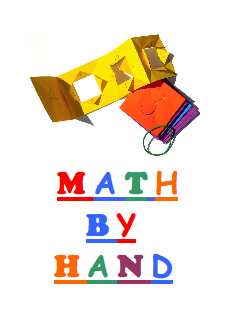June 27th, 2014 · Uncategorized

A Year in the Life: Ambient Math Wins the Race to the Top!
Day 163
For one year, 365 days, this blog will address the Common Core Standards from the perspective of creating an alternate, ambient learning environment for math. Ambient is defined as “existing or present on all sides, an all-encompassing atmosphere.” And ambient music is defined as: “Quiet and relaxing with melodies that repeat many times.
Why ambient? A math teaching style that’s whole and all encompassing, with themes that repeat many times through the years, is most likely to be effective and successful. Today’s post will continue reviewing the Common Core ELA standards, which are listed in blue and are followed by their ambient counterparts.
English Language Arts Standards > Language > Grade 2
Vocabulary Acquisition and Use:
CCSS.ELA-LITERACY.L.2.4
Determine or clarify the meaning of unknown and multiple meaning words and phrases based on grade 2 reading and content, choosing flexibly from an array of strategies.
Reading may not be happening yet, and that’s fine. A rock-solid foundation is being built for excellent reading and writing skills through exposure to classic literature and verse. Grade 2 reading need not be the watered down version necessary for independent comprehension and accessibility at that age. The meanings of unknown and multiple meaning words and phrases are acquired holistically and naturally. A storehouse of skills is built effortlessly through a love of literature.
CCSS.ELA-LITERACY.L.2.4A
Use sentence-level context as a clue to the meaning of a word or phrase.
Making sense of sentence level context happens continually while listening to stories or fables. Aesop’s fables from Ancient Greece, medieval legends of saints, or classic heroes’ tales possess an integrity of language that resonates deeply with 8 year olds. As the stories are told, complex structures are puzzle-pieced together in the children’s developing minds, and an integral part of that process is a vocabulary building that has no rival in any one of a broad array of strategies.
Knowledge ensues in an environment dedicated to imaginative, creative knowing, where student and teacher alike surrender to the ensuing of knowledge as a worthy goal. Tune in tomorrow to continue with the Common Core ELA standards and their ambient counterparts.
The post L.2 4 A: A Love of Stories = A Storehouse of Skills (#163) appeared first on Math By Hand.
The post L.2 4 A: A Love of Stories = A Storehouse of Skills (#163) appeared first on Math By Hand.
The post L.2 4 A: A Love of Stories = A Storehouse of Skills (#163) appeared first on Math By Hand.
The post L.2 4 A: A Love of Stories = A Storehouse of Skills (#163) appeared first on Math By Hand.
The post L.2 4 A: A Love of Stories = A Storehouse of Skills (#163) appeared first on Math By Hand.
The post L.2 4 A: A Love of Stories = A Storehouse of Skills (#163) appeared first on Math By Hand.
Tags:
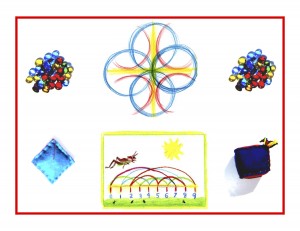
Day 162
For one year, 365 days, this blog will address the Common Core Standards from the perspective of creating an alternate, ambient learning environment for math. Ambient is defined as “existing or present on all sides, an all-encompassing atmosphere.” And ambient music is defined as: “Quiet and relaxing with melodies that repeat many times.
Why ambient? A math teaching style that’s whole and all encompassing, with themes that repeat many times through the years, is most likely to be effective and successful. Another fun post today. We’re building a new Math By Hand website, and so much time and effort is devoted there that there’s less energy for anything else. Having fun with the blog is less taxing than writing about the Common Core! And needless to say, it’s more fun.
Today’s offering would be an excellent addition to your math skills practice. Since Waldorf subjects are taught in blocks and there are only 3-4 math blocks per year, it’s essential to have a daily math skills practice time in between blocks. Even practice however, needs to be artfully and joyfully approached. Color and creativity are key!
See the image below: a number acrostic. And here’s how to set it up:
These are odd and even numbered puzzles, but you can come up with other variations as well.
Write a column of 6 sequential numbers on the right, with a vertical line to separate them from the equations.
Reverse the order of numbers on the right. Equals signs separate them from the equations.
Fill in the middle with equations that make the answers work.
All 4 processes need to be used.
Happy students make better math students. Make math practice fun with games, movement, and patterns. Once started, the ideas will flow freely, and you will be rewarded with math lessons that are pleasant to teach and students who l-o-v-e the subject!
Knowledge ensues in an environment dedicated to imaginative, creative knowing, where student and teacher alike surrender to the ensuing of knowledge as a worthy goal. Tune in tomorrow to continue with the Common Core ELA standards and their ambient counterparts.
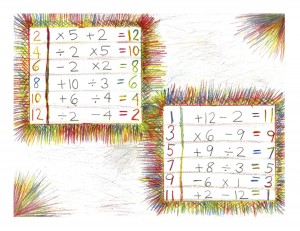
Tags:
June 27th, 2014 · Uncategorized

A Year in the Life: Ambient Math Wins the Race to the Top!
Day 162
For one year, 365 days, this blog will address the Common Core Standards from the perspective of creating an alternate, ambient learning environment for math. Ambient is defined as “existing or present on all sides, an all-encompassing atmosphere.” And ambient music is defined as: “Quiet and relaxing with melodies that repeat many times.
Why ambient? A math teaching style that’s whole and all encompassing, with themes that repeat many times through the years, is most likely to be effective and successful. Another fun post today. We’re building a new Math By Hand website, and so much time and effort is devoted there that there’s less energy for anything else. Having fun with the blog is less taxing than writing about the Common Core! And needless to say, it’s more fun.
Today’s offering would be an excellent addition to your math skills practice. Since Waldorf subjects are taught in blocks and there are only 3-4 math blocks per year, it’s essential to have a daily math skills practice time in between blocks. Even practice however, needs to be artfully and joyfully approached. Color and creativity are key!
See the image below: a number acrostic. And here’s how to set it up:
These are odd and even numbered puzzles, but you can come up with other variations as well.
Write a column of 6 sequential numbers on the right, with a vertical line to separate them from the equations.
Reverse the order of numbers on the right. Equals signs separate them from the equations.
Fill in the middle with equations that make the answers work.
All 4 processes need to be used.
Happy students make better math students. Make math practice fun with games, movement, and patterns. Once started, the ideas will flow freely, and you will be rewarded with math lessons that are pleasant to teach and students who l-o-v-e the subject!
Knowledge ensues in an environment dedicated to imaginative, creative knowing, where student and teacher alike surrender to the ensuing of knowledge as a worthy goal. Tune in tomorrow to continue with the Common Core ELA standards and their ambient counterparts.

The post Number Acrostics: Have Fun With Math Skills Practice (#162) appeared first on Math By Hand.
The post Number Acrostics: Have Fun With Math Skills Practice (#162) appeared first on Math By Hand.
The post Number Acrostics: Have Fun With Math Skills Practice (#162) appeared first on Math By Hand.
The post Number Acrostics: Have Fun With Math Skills Practice (#162) appeared first on Math By Hand.
The post Number Acrostics: Have Fun With Math Skills Practice (#162) appeared first on Math By Hand.
The post Number Acrostics: Have Fun With Math Skills Practice (#162) appeared first on Math By Hand.
Tags:

A Year in the Life: Ambient Math Wins the Race to the Top!
Day 162
For one year, 365 days, this blog will address the Common Core Standards from the perspective of creating an alternate, ambient learning environment for math. Ambient is defined as “existing or present on all sides, an all-encompassing atmosphere.” And ambient music is defined as: “Quiet and relaxing with melodies that repeat many times.
Why ambient? A math teaching style that’s whole and all encompassing, with themes that repeat many times through the years, is most likely to be effective and successful. Another fun post today. We’re building a new Math By Hand website, and so much time and effort is devoted there that there’s less energy for anything else. Having fun with the blog is less taxing than writing about the Common Core! And needless to say, it’s more fun.
Today’s offering would be an excellent addition to your math skills practice. Since Waldorf subjects are taught in blocks and there are only 3-4 math blocks per year, it’s essential to have a daily math skills practice time in between blocks. Even practice however, needs to be artfully and joyfully approached. Color and creativity are key!
See the image below: a number acrostic. And here’s how to set it up:
These are odd and even numbered puzzles, but you can come up with other variations as well.
Write a column of 6 sequential numbers on the right, with a vertical line to separate them from the equations.
Reverse the order of numbers on the right. Equals signs separate them from the equations.
Fill in the middle with equations that make the answers work.
All 4 processes need to be used.
Happy students make better math students. Make math practice fun with games, movement, and patterns. Once started, the ideas will flow freely, and you will be rewarded with math lessons that are pleasant to teach and students who l-o-v-e the subject!
Knowledge ensues in an environment dedicated to imaginative, creative knowing, where student and teacher alike surrender to the ensuing of knowledge as a worthy goal. Tune in tomorrow to continue with the Common Core ELA standards and their ambient counterparts.

The post Number Acrostics: Have Fun With Math Skills Practice (#162) appeared first on Math By Hand.
The post Number Acrostics: Have Fun With Math Skills Practice (#162) appeared first on Math By Hand.
The post Number Acrostics: Have Fun With Math Skills Practice (#162) appeared first on Math By Hand.
The post Number Acrostics: Have Fun With Math Skills Practice (#162) appeared first on Math By Hand.
The post Number Acrostics: Have Fun With Math Skills Practice (#162) appeared first on Math By Hand.
The post Number Acrostics: Have Fun With Math Skills Practice (#162) appeared first on Math By Hand.
Tags:
June 25th, 2014 · Uncategorized

A Year in the Life: Ambient Math Wins the Race to the Top!
Day 161
For one year, 365 days, this blog will address the Common Core Standards from the perspective of creating an alternate, ambient learning environment for math. Ambient is defined as “existing or present on all sides, an all-encompassing atmosphere.” And ambient music is defined as: “Quiet and relaxing with melodies that repeat many times.
Why ambient? A math teaching style that’s whole and all encompassing, with themes that repeat many times through the years, is most likely to be effective and successful. Today’s post will take a bit of a fun break. The very first thing in the Math By Hand Grade 2 year is creating a very large wall chart/poster with all of the times tables. Ideally, the tables should be known well by mid or end of Grade 3.
Folding the chart is a lesson in itself, since it’s folded several times to create 144 boxes. Then the idea is to fill in as many of the known tables as possible. By the end of Grade 1, the 2, 5, and 10 tables are known. So those are filled in both ways, the 1′s of course, and the 11′s are just double numbers! So you see, a good portion of the chart is filled in, and this is very empowering, an excellent start! This chart is posted in a prominent place so the tables are partially learned by immersion, and then it serves as a prompt for as long as its needed.
Toward the end of Grade 2 another, more whimsical chart could be made. Here’s how to make the times tables spider web pictured below. All you need is a large piece of poster paper, colored pencils, and a #2 pencil. (You can get free “end rolls” from your local newspaper, 12″ to 36″ wide and many feet long.)
1) draw a large cross with yellow pencil, centered on the paper
2) add two x’s with yellow pencil, one wide and one narrow, evenly spaced.
3) draw 12 circles touching each other, along each line from the center
4) using a times tables chart for reference, use a #2 pencil to fill in all the tables, starting with the 1′s
5) choose a different color to connect each times table’s numbers with cross lines
6) draw the spider in the corner!
Knowledge ensues in an environment dedicated to imaginative, creative knowing, where student and teacher alike surrender to the ensuing of knowledge as a worthy goal. Tune in tomorrow to continue with the Common Core ELA standards and their ambient counterparts.

The post A Friendly Spider’s Web Weaves Times Tables Fun (#161) appeared first on Math By Hand.
The post A Friendly Spider’s Web Weaves Times Tables Fun (#161) appeared first on Math By Hand.
The post A Friendly Spider’s Web Weaves Times Tables Fun (#161) appeared first on Math By Hand.
The post A Friendly Spider’s Web Weaves Times Tables Fun (#161) appeared first on Math By Hand.
The post A Friendly Spider’s Web Weaves Times Tables Fun (#161) appeared first on Math By Hand.
The post A Friendly Spider’s Web Weaves Times Tables Fun (#161) appeared first on Math By Hand.
Tags:
June 24th, 2014 · Uncategorized

A Year in the Life: Ambient Math Wins the Race to the Top!
Day 161
For one year, 365 days, this blog will address the Common Core Standards from the perspective of creating an alternate, ambient learning environment for math. Ambient is defined as “existing or present on all sides, an all-encompassing atmosphere.” And ambient music is defined as: “Quiet and relaxing with melodies that repeat many times.
Why ambient? A math teaching style that’s whole and all encompassing, with themes that repeat many times through the years, is most likely to be effective and successful. Today’s post will take a bit of a fun break. The very first thing in the Math By Hand Grade 2 year is creating a very large wall chart/poster with all of the times tables. Ideally, the tables should be known well by mid or end of Grade 3.
Folding the chart is a lesson in itself, since it’s folded several times to create 144 boxes. Then the idea is to fill in as many of the known tables as possible. By the end of Grade 1, the 2, 5, and 10 tables are known. So those are filled in both ways, the 1′s of course, and the 11′s are just double numbers! So you see, a good portion of the chart is filled in, and this is very empowering, an excellent start! This chart is posted in a prominent place so the tables are partially learned by immersion, and then it serves as a prompt for as long as its needed.
Toward the end of Grade 2 another, more whimsical chart could be made. Here’s how to make the times tables spider web pictured below. All you need is a large piece of poster paper, colored pencils, and a #2 pencil. (You can get free “end rolls” from your local newspaper, 12″ to 36″ wide and many feet long.)
1) draw a large cross with yellow pencil, centered on the paper
2) add two x’s with yellow pencil, one wide and one narrow, evenly spaced.
3) draw 12 circles touching each other, along each line from the center
4) using a times tables chart for reference, use a #2 pencil to fill in all the tables, starting with the 1′s
5) choose a different color to connect each times table’s numbers with cross lines
6) draw the spider in the corner!
Knowledge ensues in an environment dedicated to imaginative, creative knowing, where student and teacher alike surrender to the ensuing of knowledge as a worthy goal. Tune in tomorrow to continue with the Common Core ELA standards and their ambient counterparts.

The post A Friendly Spider’s Web Weaves Times Tables Fun (#161) appeared first on Math By Hand.
The post A Friendly Spider’s Web Weaves Times Tables Fun (#161) appeared first on Math By Hand.
The post A Friendly Spider’s Web Weaves Times Tables Fun (#161) appeared first on Math By Hand.
The post A Friendly Spider’s Web Weaves Times Tables Fun (#161) appeared first on Math By Hand.
The post A Friendly Spider’s Web Weaves Times Tables Fun (#161) appeared first on Math By Hand.
The post A Friendly Spider’s Web Weaves Times Tables Fun (#161) appeared first on Math By Hand.
Tags:
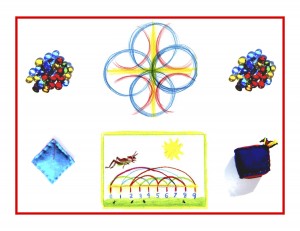
Day 160
For one year, 365 days, this blog will address the Common Core Standards from the perspective of creating an alternate, ambient learning environment for math. Ambient is defined as “existing or present on all sides, an all-encompassing atmosphere.” And ambient music is defined as: “Quiet and relaxing with melodies that repeat many times.
Why ambient? A math teaching style that’s whole and all encompassing, with themes that repeat many times through the years, is most likely to be effective and successful. Today’s post will continue reviewing the Common Core ELA standards, which are listed in blue and are followed by their ambient counterparts.
English Language Arts Standards > Language > Grade 2
Knowledge of Language:
CCSS.ELA-LITERACY.L.2.3
Use knowledge of language and its conventions when writing, speaking, reading, or listening.
CCSS.ELA-LITERACY.L.2.3A
Compare formal and informal uses of English.
Both of these standards are well covered by learning and reciting poetry. As poems are learned through line-by-line memorization and recitation, focused listening and then precise speaking is required. As for writing and reading, after the poems have been memorized, they can be copied from the teacher’s example along with colorful illustrations. Because they’ve been learned “by heart,” reading can be taught through writing in this way.
A clear awareness of the differences between formal and informal English is essential in later grades, but it may be too soon to differentiate between them in an abstract way. Of course the children will experience examples of both as an everyday occurrence in the ways the adults around them communicate to suit various situations. An imaginative feeling for the differences can be relayed through stories and poetry.
The first poem below, “Escape At Bedtime” by Robert Louis Stevenson, is a study in formal language. And the second, “The Jumblies” by Edward Lear, is just the first verse from one of the many nonsense poems that can be found and used to represent informal language. Your second graders will love the challenge and will greatly benefit from the process of learning, memorizing, reciting, writing, and illustrating poetry!
Escape at Bedtime
By Robert Louis Stevenson
The lights from the parlor and kitchen shone out
Through the blinds and the windows and bars,
And high overhead and all moving about,
There were thousands of millions of stars.
There never were such thousands of leaves on a tree,
Nor of people in church or the park,
As the crowds of the stars that looked down upon me,
And that glittered and winked in the dark
The Dog and the Plough, and the Hunter, and all,
And the star of the sailor, and Mars,
Those shone in the sky, and the pail by the wall
Would be half full of water and stars.
They saw me at last, and they chased me with cries,
And they soon had me packed into bed,
But the glory kept shining and bright in my eyes,
And the stars going round in my head.
The Jumblies
By Edward Lear
They went to sea in a Sieve, they did,
In a Sieve they went to sea:
In spite of all their friends could say,
On a winter’s morn, on a stormy day,
In a Sieve they went to sea!
And when the Sieve turned round and round,
And every one cried, ‘You’ll all be drowned!’
They called aloud, ‘Our Sieve ain’t big,
But we don’t care a button! we don’t care a fig!
In a Sieve we’ll go to sea!’
Far and few, far and few,
Are the lands where the Jumblies live;
Their heads are green, and their hands are blue,
And they went to sea in a Sieve.
Knowledge ensues in an environment dedicated to imaginative, creative knowing, where student and teacher alike surrender to the ensuing of knowledge as a worthy goal. Tune in tomorrow to continue with the Common Core ELA standards and their ambient counterparts.
Tags:
June 22nd, 2014 · Uncategorized

A Day in the Life: Ambient Math Wins the Race to the Top!
Day 160
For one year, 365 days, this blog will address the Common Core Standards from the perspective of creating an alternate, ambient learning environment for math. Ambient is defined as “existing or present on all sides, an all-encompassing atmosphere.” And ambient music is defined as: “Quiet and relaxing with melodies that repeat many times.
Why ambient? A math teaching style that’s whole and all encompassing, with themes that repeat many times through the years, is most likely to be effective and successful. Today’s post will continue reviewing the Common Core ELA standards, which are listed in blue and are followed by their ambient counterparts.
English Language Arts Standards > Language > Grade 2
Knowledge of Language:
CCSS.ELA-LITERACY.L.2.3
Use knowledge of language and its conventions when writing, speaking, reading, or listening.
CCSS.ELA-LITERACY.L.2.3A
Compare formal and informal uses of English.
Both of these standards are well covered by learning and reciting poetry. As poems are learned through line-by-line memorization and recitation, focused listening and then precise speaking is required. As for writing and reading, after the poems have been memorized, they can be copied from the teacher’s example along with colorful illustrations. Because they’ve been learned “by heart,” reading can be taught through writing in this way.
A clear awareness of the differences between formal and informal English is essential in later grades, but it may be too soon to differentiate between them in an abstract way. Of course the children will experience examples of both as an everyday occurrence in the ways the adults around them communicate to suit various situations. An imaginative feeling for the differences can be relayed through stories and poetry.
The first poem below, “Escape At Bedtime” by Robert Louis Stevenson, is a study in formal language. And the second, “The Jumblies” by Edward Lear, is just the first verse from one of the many nonsense poems that can be found and used to represent informal language. Your second graders will love the challenge and will greatly benefit from the process of learning, memorizing, reciting, writing, and illustrating poetry!
Escape at Bedtime
By Robert Louis Stevenson
The lights from the parlor and kitchen shone out
Through the blinds and the windows and bars,
And high overhead and all moving about,
There were thousands of millions of stars.
There never were such thousands of leaves on a tree,
Nor of people in church or the park,
As the crowds of the stars that looked down upon me,
And that glittered and winked in the dark
The Dog and the Plough, and the Hunter, and all,
And the star of the sailor, and Mars,
Those shone in the sky, and the pail by the wall
Would be half full of water and stars.
They saw me at last, and they chased me with cries,
And they soon had me packed into bed,
But the glory kept shining and bright in my eyes,
And the stars going round in my head.
The Jumblies
By Edward Lear
They went to sea in a Sieve, they did,
In a Sieve they went to sea:
In spite of all their friends could say,
On a winter’s morn, on a stormy day,
In a Sieve they went to sea!
And when the Sieve turned round and round,
And every one cried, ‘You’ll all be drowned!’
They called aloud, ‘Our Sieve ain’t big,
But we don’t care a button! we don’t care a fig!
In a Sieve we’ll go to sea!’
Far and few, far and few,
Are the lands where the Jumblies live;
Their heads are green, and their hands are blue,
And they went to sea in a Sieve.
Knowledge ensues in an environment dedicated to imaginative, creative knowing, where student and teacher alike surrender to the ensuing of knowledge as a worthy goal. Tune in tomorrow to continue with the Common Core ELA standards and their ambient counterparts.
The post L.2 3 A: Reciting, Writing & Reading Classic Poetry (#160) appeared first on Math By Hand.
Tags:
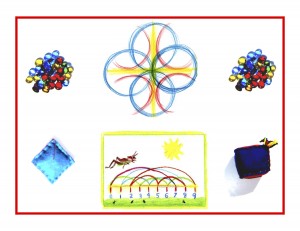
Day 159
For one year, 365 days, this blog will address the Common Core Standards from the perspective of creating an alternate, ambient learning environment for math. Ambient is defined as “existing or present on all sides, an all-encompassing atmosphere.” And ambient music is defined as: “Quiet and relaxing with melodies that repeat many times.
Why ambient? A math teaching style that’s whole and all encompassing, with themes that repeat many times through the years, is most likely to be effective and successful. Today’s post will continue reviewing the Common Core ELA standards, which are listed in blue and are followed by their ambient counterparts.
English Language Arts Standards > Language > Grade 2
Conventions of Standard English:
CCSS.ELA-LITERACY.L.2.2
Demonstrate command of the conventions of standard English capitalization, punctuation, and spelling when writing.
2.2.A
Capitalize holidays, product names and geographic names.
2.2.B
Use commas in greetings and closings of letters.
2.2.C
Use an apostrophe to form contractions and frequently occurring possessives.
2.2.D
Generalize learned spelling patterns when writing words (e.g., cage > badge; boy > boil).
2.2.E
Consult reference materials, including beginning dictionaries, as needed to check and correct spellings.
For much of this detailed busy work, teachers are relying on worksheets. In class or sent home, there are many, too many. Schools are purchasing worksheet books and having children go through them page by page, every day at school, every night at home. All I’d like to say in this post is that worksheets are deadening rather than enlivening, and I wonder how many adults would be able to sustain interest in such “seat work” so-called. At any rate, here is an example, labeled CCSS, for proper noun capitalization. Look at it with an eye toward whether it’s a fitting substitute for creating beautiful books that record and illustrate every lesson, beautifully, every day.
Knowledge ensues in an environment dedicated to imaginative, creative knowing, where student and teacher alike surrender to the ensuing of knowledge as a worthy goal. Tune in tomorrow to continue with the Common Core ELA standards and their ambient counterparts.
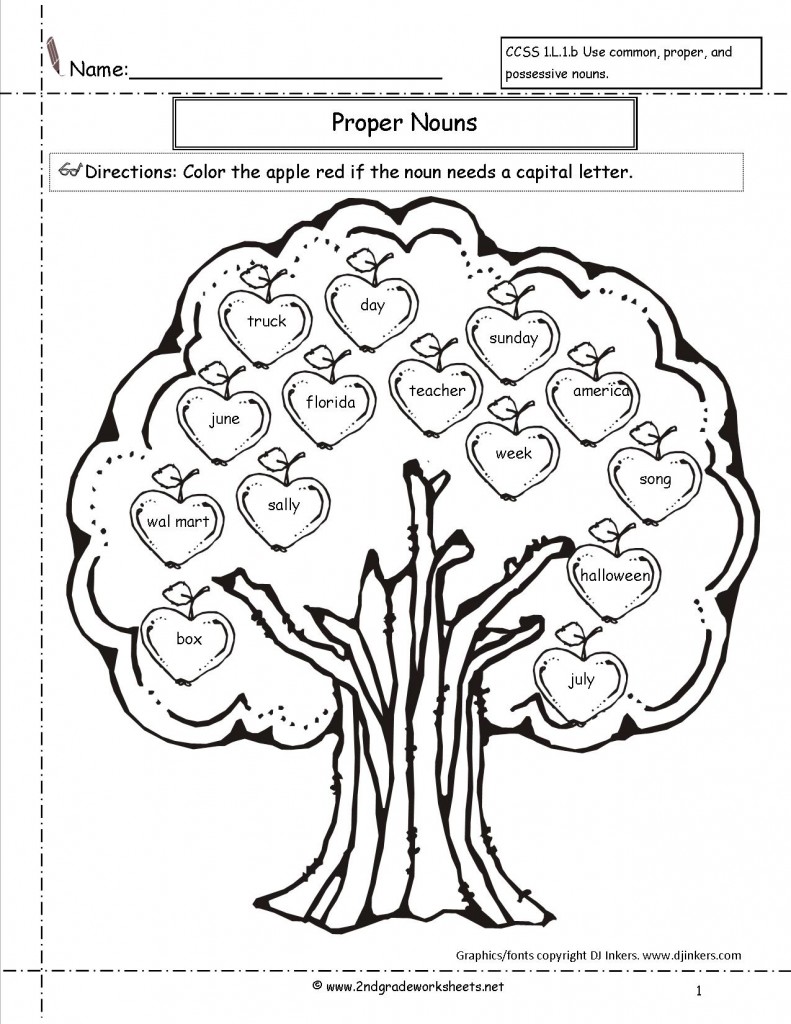
Tags:
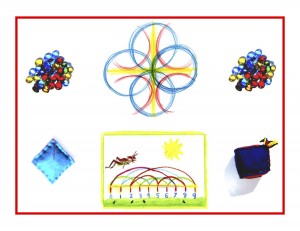
Day 158
For one year, 365 days, this blog will address the Common Core Standards from the perspective of creating an alternate, ambient learning environment for math. Ambient is defined as “existing or present on all sides, an all-encompassing atmosphere.” And ambient music is defined as: “Quiet and relaxing with melodies that repeat many times.
Why ambient? A math teaching style that’s whole and all encompassing, with themes that repeat many times through the years, is most likely to be effective and successful. Today’s post will continue reviewing the Common Core ELA standards, which are listed in blue and are followed by their ambient counterparts.
English Language Arts Standards > Language > Grade 2
Conventions of Standard English:
CCSS.ELA-LITERACY.L.2.1
Demonstrate command of the conventions of standard English grammar and usage when writing or speaking.
2.1.A
Use collective nouns (e.g., group).
2.1.B
Form and use frequently occurring irregular plural nouns (e.g., feet, children, teeth, mice, fish).
2.1.C
Use reflexive pronouns (e.g., myself, ourselves).
2.1.D
Form and use the past tense of frequently occurring irregular verbs (e.g., sat, hid, told)>
2.1.E
Use adjectives and adverbs, and choose between them depending on what is to be modified.
2.1.F
Produce, expand, and rearrange complete simple and compound sentences (e.g., The boy watched the movie; The little boy watched the movie; The action movie was watched by the little boy).
These standards have all been grouped together because they are an excellent example of dissecting the whole to get to the parts. So much more can be accomplished by starting with the whole and allowing the parts to appear of themselves when the time is right and ripe! If children are read or told stories from classic or complex literature, they will very likely in future become great readers and writers.
Notice that the example sentence in standard 2.1.F is neither classic nor is it complex in its interest, vocabulary, and structure. It comes from the same genre as the “See Spot Run” or “Dick and Jane” series. Children at any age know when subject matter is condescending or dumbed down. In the Waldorf second grade, classic fables are told, as well as saints and heroes stories and legends. They are humorous, inspirational, and complex, and certainly not watered down for easier consumption.
William Steig was one of our favorite authors when my daughter was in second grade. His writing is both humorous and complex. The scope of vocabulary and plot is impressive, and the illustrations are wonderful! Read and enjoy this excerpt from one of our very favorites: “Gorky Rises.” And consider reading and telling stories of this calibre to engender both a love of reading and good writing skills.
Knowledge ensues in an environment dedicated to imaginative, creative knowing, where student and teacher alike surrender to the ensuing of knowledge as a worthy goal. Tune in tomorrow to continue with the Common Core ELA standards and their ambient counterparts.
As soon as his parents kissed him goodbye and left, Gorky set up his laboratory by the kitchen sink and got to work. He took a clean tumbler, let in one squirt of water, and added first a little of this and then a little of that: a spoon each of chicken soup, tea, and vinegar, a sprinkle of coffee grounds, one shake of talcum powder, two shakes of paprika, a dash of cinnamon, a splash of witch hazel. He stirred vigorously and held the mixture up to the light. Too murky.
Very carefully, he put in a bit of his father’s clear cognac. Better. But something still was missing. What? Aha! Attar of roses. Gorky stepped out of his laboratory to fetch his mother’s best perfume. He meant to use just a few drops; but, ravished by the scent of roses, he recklessly poured in all there was–half a bottle.
That did it! The thick stuff sank to the bottom of the mixing glass and he had a reddish-golden liquid full of tiny bubbles that glinted like particles of fire. This, obviously, was the magic formula he had long been seeking. With a steady hand, he decanted the pure bubble part into the perfume bottom and firmly closed it with the glass stopper. Then he went out into the sunlight.




Tags:

